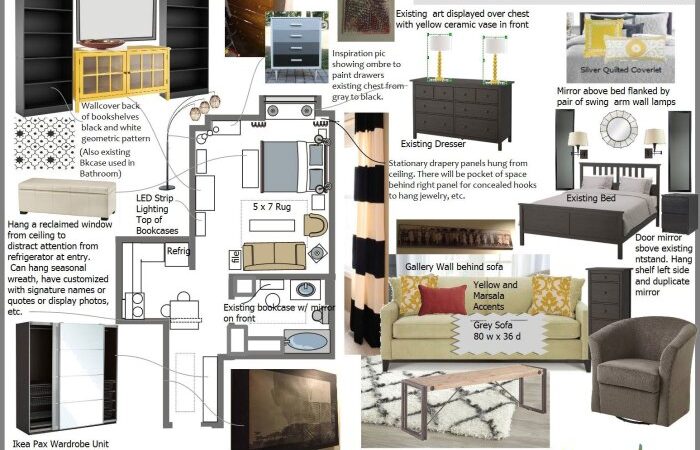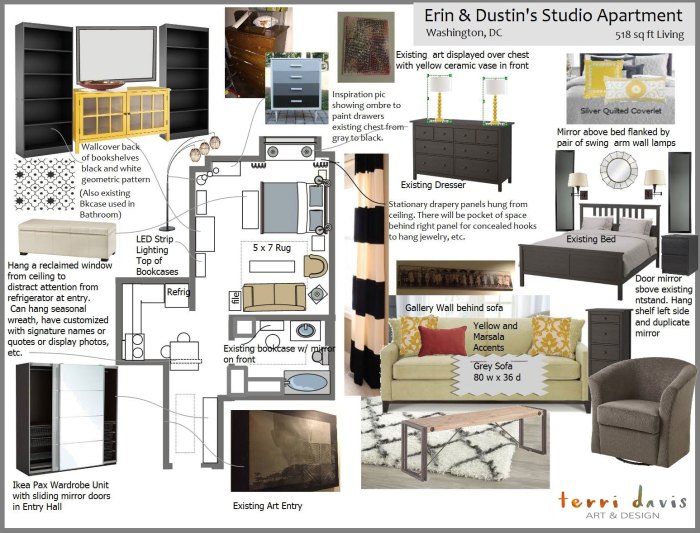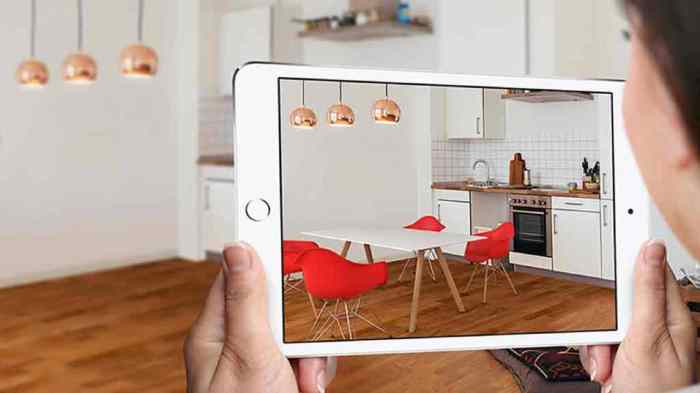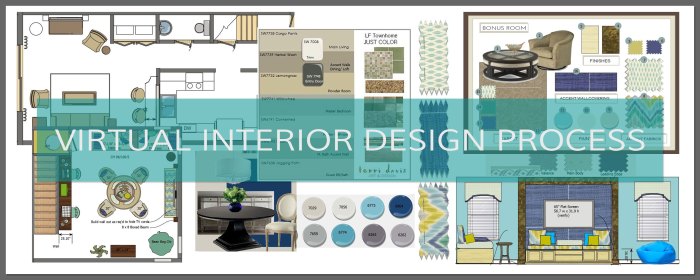Virtual Interior Design: Shaping Spaces Digitally

Virtual interior design has revolutionized the way we envision and create our living spaces. It empowers homeowners and designers to explore countless possibilities before committing to physical changes, offering a seamless blend of technology and creativity.
This innovative approach allows for interactive 3D visualizations, enabling clients to experience their dream interiors virtually. Through user-friendly platforms and advanced tools, virtual interior design simplifies the design process, making it accessible and engaging for everyone.
Introduction to Virtual Interior Design

Virtual interior design is a process that allows individuals to create and visualize their dream spaces using digital tools and software. It provides a realistic representation of how a space will look and feel before any physical changes are made.
The purpose of virtual interior design is to facilitate informed decision-making, enhance the design process, and minimize potential design errors. Virtual interior design offers numerous advantages over traditional methods. It eliminates the need for physical samples, reduces the risk of costly mistakes, and allows for greater experimentation and customization.
Moreover, virtual design tools enable clients to actively participate in the design process, providing valuable feedback and ensuring that the final design meets their specific needs and preferences.
Examples of Virtual Interior Design Platforms
Virtual interior design platforms are widely available, offering a range of features and functionalities to cater to diverse user needs. These platforms can be categorized based on their target audience, functionality, and pricing models.
- Consumer-focused platforms: These platforms are designed for individuals who want to explore design ideas, experiment with different furniture arrangements, and visualize their space before making any purchases. Examples include:
- Roomstyler: This platform allows users to create 3D models of their rooms and experiment with different furniture and décor options. It offers a vast library of furniture and décor items from various brands.
- Planner 5D: This platform provides a user-friendly interface for creating 2D and 3D floor plans and visualizing different design options. It offers a wide range of customization options and allows users to share their designs with others.
- Professional-grade platforms: These platforms are designed for interior designers and architects who require advanced tools and features for creating high-quality renderings and presentations. Examples include:
- SketchUp: This platform is widely used by architects and designers for creating 3D models and visualizations. It offers a powerful set of tools for modeling, rendering, and creating presentations.
- Autodesk Revit: This platform is a comprehensive BIM (Building Information Modeling) software that allows designers to create detailed 3D models of buildings and interiors. It integrates with other design tools and offers advanced features for visualization, analysis, and collaboration.
“Virtual interior design platforms have revolutionized the design industry, offering a more efficient, collaborative, and cost-effective approach to creating and visualizing spaces.”
Virtual Interior Design Process

The virtual interior design process is a collaborative journey that involves a series of steps to transform your vision into a beautiful and functional space. From initial consultations to final design presentations, the process is designed to ensure your satisfaction and create a space that reflects your unique style and needs.
Client Communication and Collaboration
Client communication and collaboration are integral to the success of any virtual interior design project. The virtual nature of the process allows for greater flexibility and accessibility, fostering a strong connection between the designer and the client.
- Initial Consultation: This is the first step where you discuss your project goals, budget, and design preferences. The designer will ask questions to understand your lifestyle, needs, and vision for the space.
- Project Scope and Timeline: Once you have a clear understanding of the project scope, the designer will create a timeline outlining the key milestones and deliverables.
- Design Concept Development: The designer will present initial design concepts based on your feedback and preferences. This may involve mood boards, 3D renderings, and floor plans.
- Feedback and Revisions: You will have the opportunity to provide feedback on the design concepts and request revisions. The designer will work with you to ensure the final design meets your expectations.
- Final Presentation: The designer will present the final design, including detailed drawings, material selections, and furniture specifications.
Process Flowchart
The virtual interior design process can be visualized as a flowchart, outlining the key milestones and steps involved.
| Milestone | Description |
|---|---|
| Initial Consultation | Discussing project goals, budget, and design preferences. |
| Project Scope and Timeline | Defining project scope and creating a timeline for completion. |
| Space Planning and Layout | Developing floor plans and furniture arrangements. |
| Design Concept Development | Presenting initial design concepts, including mood boards and 3D renderings. |
| Client Feedback and Revisions | Reviewing and providing feedback on design concepts and requesting revisions. |
| Final Design Presentation | Presenting the final design, including detailed drawings, material selections, and furniture specifications. |
Virtual Interior Design Tools and Technologies
Virtual interior design relies heavily on a range of software and technologies that enable designers to create and present realistic and immersive design concepts. These tools streamline the design process, enhance client communication, and allow for more accurate visualization of the final project.
Virtual Interior Design Tools
Virtual interior design tools provide designers with the ability to create detailed and realistic 3D models of spaces, experiment with different furniture arrangements, materials, and colors, and generate immersive virtual tours. These tools enhance the design process, allowing for better visualization, client collaboration, and accurate project planning.
| Tool Name | Description | Features | Examples |
|---|---|---|---|
| SketchUp | A user-friendly 3D modeling software widely used for architectural and interior design. | Intuitive interface, easy-to-use modeling tools, extensive library of 3D models, and integration with other design software. | Creating floor plans, visualizing furniture arrangements, and exploring different material options. |
| Revit | A powerful BIM (Building Information Modeling) software used for architectural and interior design projects. | Advanced modeling capabilities, detailed documentation features, integrated design analysis tools, and collaboration features for large projects. | Creating detailed 3D models of buildings, managing building information, and simulating lighting and energy performance. |
| Autodesk 3ds Max | A professional 3D modeling and rendering software used for creating high-quality visualizations. | Advanced modeling and animation tools, powerful rendering capabilities, support for various file formats, and integration with other Autodesk software. | Creating photorealistic renderings, generating immersive virtual tours, and animating objects and scenes. |
| Lumion | A real-time rendering software specifically designed for architectural and interior visualization. | Fast rendering speeds, intuitive interface, extensive library of materials and objects, and integration with other design software. | Creating high-quality visualizations, generating walkthroughs and flyovers, and adding realistic lighting and effects. |
3D Modeling Software Functionalities
D modeling software plays a crucial role in virtual interior design, enabling designers to create realistic and interactive representations of spaces. These software programs offer a wide range of functionalities that streamline the design process and enhance client communication.
- Floor Plan Creation: 3D modeling software allows designers to create accurate floor plans, defining the dimensions, layout, and features of a space. This provides a foundational base for further design development.
- Furniture Placement and Arrangement: Designers can virtually place and arrange furniture within the 3D model, experimenting with different configurations and assessing their impact on space flow and functionality.
- Material Selection and Visualization: 3D modeling software enables designers to explore various materials, finishes, and textures, visualizing their appearance in the final design. This allows for informed material choices that align with the desired aesthetic and functionality.
- Lighting Simulation: These software programs offer tools to simulate natural and artificial lighting, allowing designers to assess the impact of light on the space’s ambiance and functionality. This helps in optimizing lighting placement and achieving the desired mood.
- Rendering and Visualization: 3D modeling software allows designers to generate photorealistic renderings of the designed space, providing clients with a clear and comprehensive understanding of the final design.
Virtual Reality (VR) and Augmented Reality (AR)
VR and AR technologies have revolutionized the interior design experience, providing immersive and interactive ways to visualize and experience design concepts. These technologies enhance client engagement, communication, and understanding of the final project.
- VR for Immersive Design Exploration: VR allows clients to virtually step into the designed space, experiencing its layout, furniture arrangement, and overall ambiance. This immersive experience enhances their understanding of the design and enables them to provide valuable feedback.
- AR for Real-Time Visualization: AR overlays digital content onto the real world, allowing clients to see how furniture and decor would look in their actual space. This real-time visualization helps clients make informed decisions about furniture selection and placement.
Benefits of Virtual Interior Design
Virtual interior design has become increasingly popular in recent years, offering a convenient and cost-effective way to create beautiful and functional spaces. It leverages technology to create immersive experiences and streamline the design process, resulting in numerous advantages for both clients and designers.
Advantages for Clients
Virtual interior design offers a range of benefits for clients, including:
- Convenience: Clients can collaborate with designers remotely, eliminating the need for in-person meetings and site visits. This is particularly beneficial for individuals with busy schedules or those living in remote locations.
- Cost-effectiveness: Virtual design typically involves lower fees compared to traditional methods, as designers can save on travel and material costs. Clients can also explore different design options without incurring the expense of physical samples or prototypes.
- Interactive and Immersive Experience: Virtual reality (VR) and augmented reality (AR) technologies allow clients to visualize their space in 3D, making it easier to understand the design concept and make informed decisions. This immersive experience enhances the client’s involvement in the design process and reduces the likelihood of misinterpretations or disagreements.
- Time Efficiency: Virtual design tools expedite the design process, allowing clients to receive design proposals and make revisions more quickly. This streamlined approach saves time and effort for both the client and the designer.
- Reduced Waste: By visualizing the design in a virtual environment, clients can make informed decisions about furniture, materials, and finishes before making any purchases. This reduces the likelihood of ordering the wrong items or making costly mistakes, minimizing waste and promoting sustainability.
Advantages for Designers
Virtual interior design also presents numerous benefits for designers, including:
- Increased Efficiency: Virtual design tools enable designers to create and modify designs more efficiently, saving time and effort. They can also easily share design concepts with clients and collaborate on revisions remotely.
- Expanded Reach: Virtual design allows designers to reach a wider client base, including those living outside their local area. This expands their potential clientele and allows them to work on projects with diverse design requirements.
- Enhanced Collaboration: Virtual platforms facilitate seamless communication and collaboration between designers and clients, regardless of their physical location. This fosters a more collaborative and productive design process.
- Cost Savings: Virtual design tools reduce the need for physical samples and prototypes, saving designers money on materials and production costs. They can also minimize travel expenses by working remotely with clients.
- Environmental Sustainability: Virtual design reduces the need for physical materials and transportation, contributing to a more sustainable design process. This aligns with the growing focus on eco-friendly practices in the design industry.
Environmental Benefits
Virtual interior design contributes to a more sustainable design process by reducing:
- Material Waste: By visualizing designs virtually, clients can make informed decisions about furniture, materials, and finishes before making any purchases, minimizing waste and promoting sustainability.
- Transportation Emissions: Virtual design reduces the need for physical site visits and material deliveries, minimizing transportation emissions and contributing to a lower carbon footprint.
- Energy Consumption: Virtual design tools can reduce the need for physical prototypes and samples, which require energy for production and transportation. This contributes to a more energy-efficient design process.
Comparison to Traditional Interior Design
Virtual interior design offers several advantages over traditional methods, including:
- Cost-effectiveness: Virtual design typically involves lower fees compared to traditional methods, as designers can save on travel and material costs. Clients also benefit from lower costs, as they can explore different design options without incurring the expense of physical samples or prototypes.
- Convenience: Virtual design allows clients and designers to collaborate remotely, eliminating the need for in-person meetings and site visits. This is particularly beneficial for individuals with busy schedules or those living in remote locations.
- Increased Efficiency: Virtual design tools expedite the design process, allowing clients to receive design proposals and make revisions more quickly. This streamlined approach saves time and effort for both the client and the designer.
- Enhanced Visualization: Virtual reality (VR) and augmented reality (AR) technologies provide clients with immersive 3D visualizations of their space, making it easier to understand the design concept and make informed decisions. This reduces the likelihood of misinterpretations or disagreements.
Benefits and Examples
| Benefits | Examples |
|---|---|
| Convenience | A client in a remote location can collaborate with a designer without needing to travel for in-person meetings. |
| Cost-effectiveness | A client can explore different furniture options virtually without incurring the expense of purchasing physical samples. |
| Increased Efficiency | A designer can create and modify designs more quickly using virtual design tools, saving time and effort. |
| Enhanced Visualization | A client can experience a 3D virtual tour of their space before making any changes, allowing them to visualize the design concept and make informed decisions. |
| Reduced Waste | A client can visualize the design in a virtual environment and make informed decisions about furniture, materials, and finishes before making any purchases, minimizing waste. |
| Environmental Sustainability | Virtual design reduces the need for physical materials and transportation, contributing to a more sustainable design process. |
Challenges and Considerations

While virtual interior design offers numerous advantages, it’s crucial to acknowledge the potential challenges and considerations that may arise during the design process. These challenges can stem from technical limitations, communication gaps, or the need to ensure user-friendliness and accessibility in virtual design tools.
Understanding these challenges and implementing effective strategies to overcome them is essential for a successful virtual design project.
Technical Limitations
Technical limitations can pose challenges in virtual interior design, especially when dealing with complex spaces, intricate details, or the need for precise measurements. For example, rendering software may struggle to accurately represent materials or textures, or there might be limitations in representing the scale and proportions of furniture within the virtual space.
- Limited Rendering Capabilities: Some rendering software may struggle to accurately depict the nuances of materials, textures, and lighting, especially when dealing with complex surfaces or intricate details. This can impact the visual fidelity of the design and make it difficult to accurately represent the final look and feel of the space.
- Challenges in Scaling and Proportion: Accurately representing the scale and proportion of furniture and other elements within the virtual space can be challenging. The virtual environment may not always accurately reflect the actual size and dimensions of objects, potentially leading to misinterpretations and inconsistencies in the design.
- Difficulties in Representing Dynamic Elements: Virtual design tools may struggle to accurately represent dynamic elements like natural light, airflow, or the movement of people within the space. These factors are crucial for creating a realistic and functional design, and their limitations can impact the overall effectiveness of the virtual design.
User-Friendliness and Accessibility
Ensuring that virtual design tools are user-friendly and accessible to a wide range of users is crucial for successful adoption. This includes considering the needs of individuals with disabilities, those who are unfamiliar with technology, and those who prefer simpler interfaces.
- Intuitive Interface: Virtual design tools should have an intuitive interface that is easy to navigate and understand, even for users who are not familiar with design software. This can involve clear labeling, logical organization of tools, and helpful tutorials or guides.
- Accessibility Features: Incorporating accessibility features like screen readers, keyboard navigation, and adjustable font sizes can make virtual design tools accessible to users with disabilities. This can significantly expand the reach of virtual interior design and make it more inclusive.
- Multilingual Support: Providing multilingual support can ensure that virtual design tools are accessible to a wider global audience. This can involve translating the interface, documentation, and support materials into multiple languages.
Future Trends in Virtual Interior Design
Virtual interior design is a rapidly evolving field, driven by technological advancements and changing consumer preferences. The future holds exciting possibilities, with emerging technologies and trends poised to revolutionize the way we design and experience our living spaces.
Emerging Technologies and Trends
The integration of emerging technologies will play a pivotal role in shaping the future of virtual interior design.
- Virtual Reality (VR) and Augmented Reality (AR): VR and AR technologies are transforming the way we interact with and visualize spaces. VR allows users to immerse themselves in a virtual environment, providing a realistic and interactive experience of a designed space. AR overlays digital content onto the real world, enabling users to visualize furniture and decor in their own homes before making a purchase.
- Artificial Intelligence (AI): AI is poised to automate various aspects of virtual interior design, from generating design ideas to creating 3D models. AI-powered design tools can analyze user preferences, suggest design solutions, and optimize layouts, enhancing efficiency and personalization.
- Internet of Things (IoT): The interconnectedness of devices through the IoT will create smart homes that are responsive to user needs. Virtual interior designers will need to consider the integration of smart home technologies, such as voice assistants, automated lighting, and temperature control when designing spaces.
- 3D Printing: 3D printing is becoming increasingly accessible and affordable, enabling the creation of customized furniture and decor. Virtual interior designers will be able to incorporate 3D printed elements into their designs, allowing for greater personalization and unique design solutions.
- Sustainable Design: Sustainability is becoming a key consideration in interior design. Virtual interior design tools can help designers evaluate the environmental impact of different materials and design choices, promoting sustainable and eco-friendly design solutions.
Artificial Intelligence in Virtual Interior Design
AI has the potential to significantly enhance the capabilities of virtual interior design platforms.
- Automated Design Generation: AI algorithms can analyze user preferences, style guides, and design trends to generate personalized design ideas. This can streamline the design process, offering a wider range of options and reducing the time required for manual design.
- 3D Model Creation: AI can automate the process of creating 3D models from 2D floor plans or sketches. This can save designers time and effort, allowing them to focus on the creative aspects of design.
- Virtual Styling: AI-powered virtual stylists can suggest furniture, decor, and color palettes based on user preferences and the overall design concept. This can help users make informed decisions and create cohesive and stylish spaces.
- Real-time Feedback: AI can provide real-time feedback on design choices, suggesting improvements and optimizing layouts based on data and design principles. This can help designers refine their designs and ensure optimal functionality and aesthetics.
Future Role of Virtual Interior Design
Virtual interior design is poised to play an increasingly important role in the industry, offering numerous benefits to both designers and consumers.
- Accessibility and Affordability: Virtual interior design services are accessible to a wider audience, making professional design services more affordable.
- Personalized Design Experiences: Virtual interior design platforms allow for greater customization and personalization, enabling users to create spaces that reflect their unique style and preferences.
- Interactive and Collaborative Design: Virtual design tools facilitate interactive and collaborative design processes, allowing users to work directly with designers and provide feedback in real time.
- Sustainable Design Solutions: Virtual interior design tools can help designers promote sustainable design practices, minimizing waste and using eco-friendly materials.
- Integration with Other Technologies: Virtual interior design will continue to integrate with other technologies, such as VR, AR, and IoT, creating seamless and immersive design experiences.
Final Conclusion
As technology continues to evolve, virtual interior design is poised to play an even greater role in shaping the future of the industry. The seamless integration of digital tools and creative vision allows for personalized and sustainable design solutions, making virtual interior design an exciting and impactful force in the world of interior design.
Comments are closed.